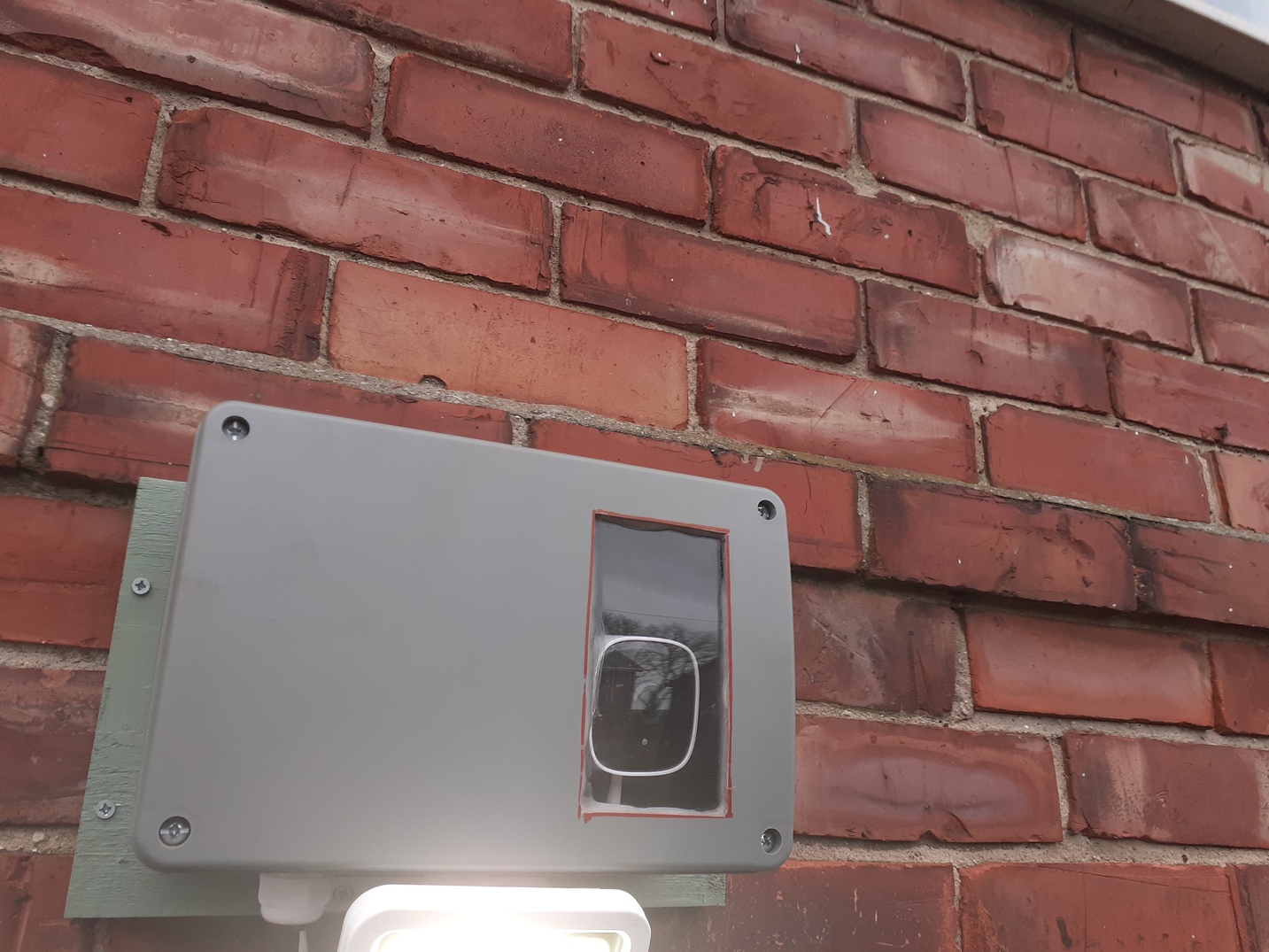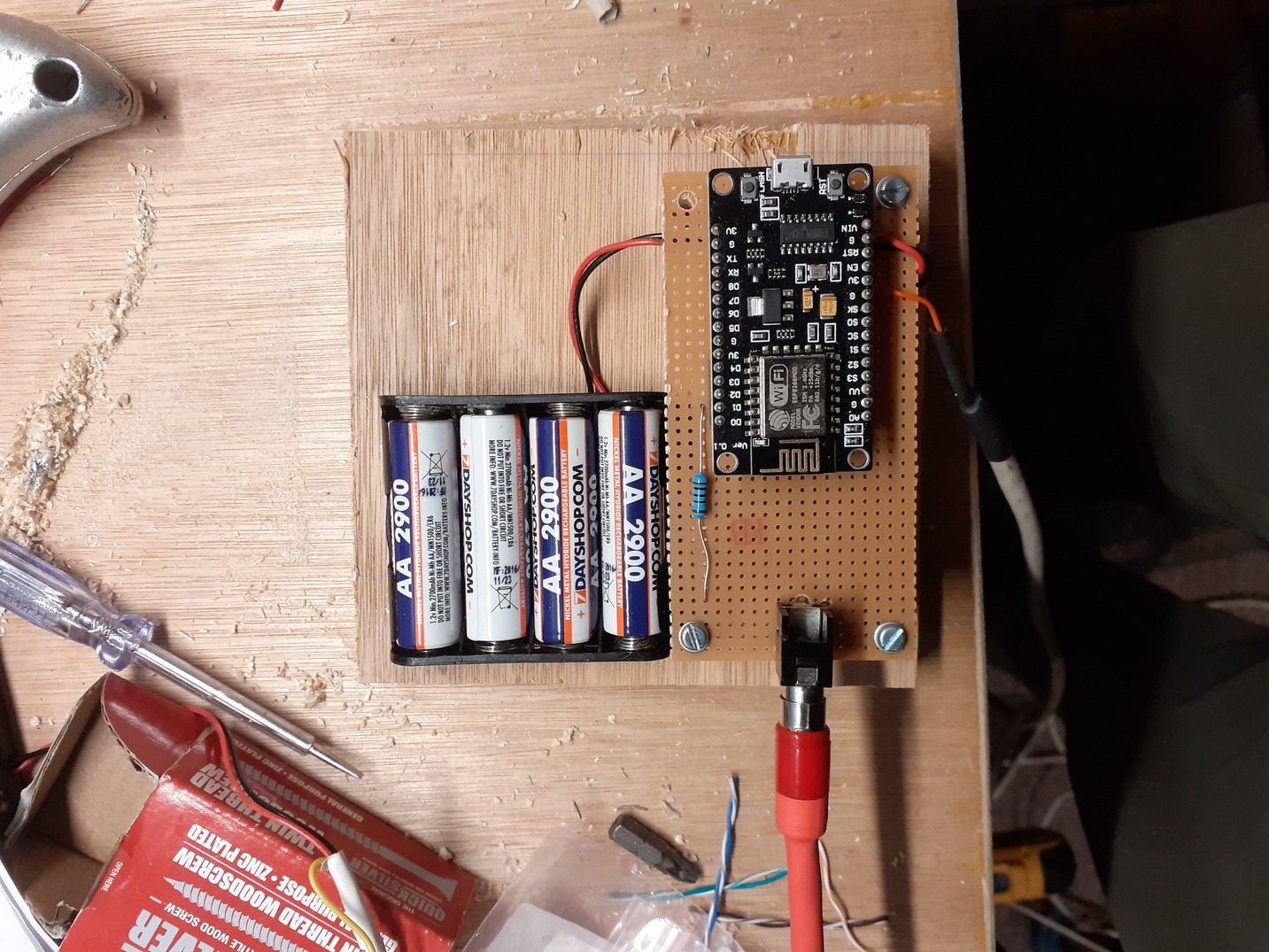Apparently one of the local bike thieves was eyeing up the bike. Certainly a car was driving down the road, crawling opposite the bike, and then driving off again. Having had one bike nicked I didn’t much fancy losing another. Thus we had to make the house look a lot more secure in a hurry; and the shops were closing that evening and not reopening till Tuesday. For it was the New Year.
CCTV
External CCTV cameras are still not exactly cheap. But internal ‘cctv/baby monitor’ cameras are now as little as £25—that with wifi. And ARGOS is open late…
Thus a cheapo camera was obtained and stuck inside by a window. I had to disable the IR leds, and the ‘motion detector’ caused a flashing alarm which blinded the camera by illuminating the window, but it worked. I left it like that for a few days while waiting for Screwfix to reopen.
Then I cut a perspex window from some scrap and glued it inside a large weatherproof box:
Then the camera was placed inside and an LED floodlight wired in via a grommet, all screwed to a wooden board:
I will not include details of how I wired it, but there was a grille directly below and I steal some current from the lighting main without having to make any holes in anything. Which is as well, as this was an emergency and I hadn’t asked the landlord.
Since I have no intention of leaving the camera connected to the proprietary network it came set up on, I set up a basic script rotating 1h files on the main computer. If I ever build a file server it can move over there. At some point we’ll see if the camera isn’t vulnerable to a hardware attack. If it still has a serial port life should be very easy; I’m pretty certain it’s running linux.
Motorcycle alarm
How do you alarm a motorcycle? I wasn’t content with just making a loud noise: does anyone really pay any attention to loud noises from alarms? We all assume it’s a mistake and ignore it. On the other hand, the bike is heavy (at least 300kg) and it is unlikely it could be moved without rolling. So a wire through the front wheel would have to be cut.
Here, then, is a basic alarm:
An ESP8266 running micropython monitors the state of a pin pulled low via he cable. Cut the cable and it will go high and trigger an alarm state. In ordinary operation the device sends an MQTT packet every n seconds. If k packets are not received, an alarm sounds inside the house. (Originally this code ran on a laptop; later it was added into the towel heater controller running in our bedroom.) The alarm has an ‘arm’ button which gives you around a minute to install before triggering if the wire isn’t there.
Here is the system installed in a waterproof box protecting the bike:
The snow gives some idea of the kind of problems we encountered:
- Using the onboard linear regulator, battery life is less than a day. (I logged discharge curves and the effect of temperature was evident).
- Wifi is quite battery consuming. But if you put the chipset to sleep it doesn’t always reconnect, so you have to increase k to handle missed packets, decreasing responsiveness.
- The ESP8266 has a deep sleep mode, but it involves rebooting the whole SoC. But the onboard code takes around a minute to come online, since at the moment I use Peter Hinch’s resilient Async MQTT driver. So the code should be rewritten with boot-sleep-reboot in mind.
In practice, it was used in this form for a few weeks, recharging batteries every day. Then the box was left with dead batteries for a bit, and then I got fed up with it and it went back inside the house. But with some redesign—the best would be for cutting the cable to trigger a power up, so the device could remain powered down for increments more like 20m, coming online only to report its battery status and then going down again—it could have the kind of battery life needed to be useful when we’re on holiday. For now, we’ve got the camera—and who really wants to nick a >10 year old Pan?
Postscript
All alarms are defeatable. This one is quite easy to defeat: the thief just needs to bridge the wire (I used some Cat5 cable just to make it harder to guess what needed bridging). If the box is opened it would be quite easy to see how to do it (although I could easily add a spring-loaded ‘box open’ alarm). But it adds one more layer of nuisance to send someone elsewhere. When I have finished restoring the previous stolen bike I mean to build something much more reliable of the same kind, to give me some certainty that the bike really is there.










